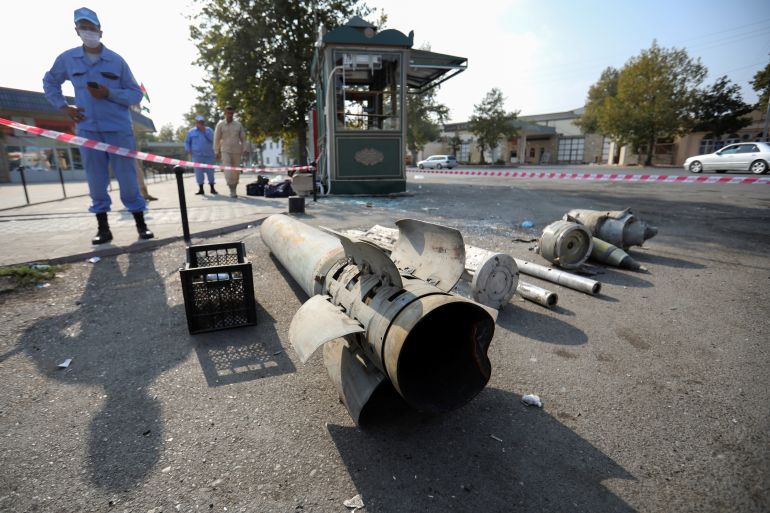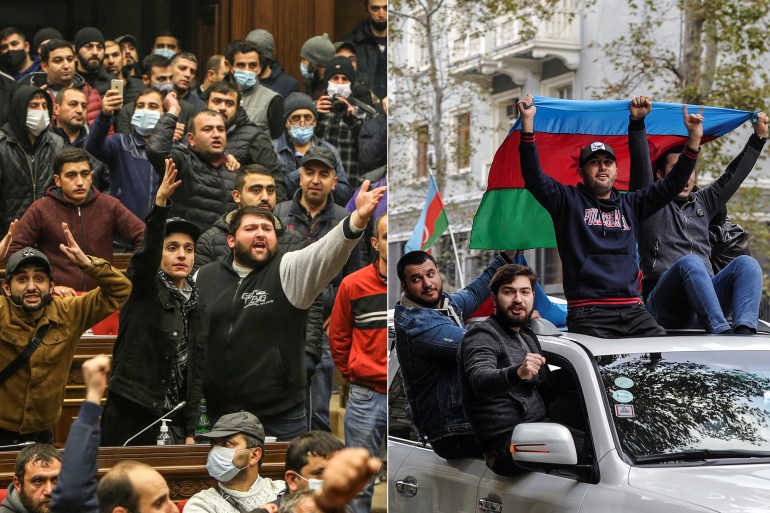Is the Nagorno-Karabakh war really over?
As euphoric crowds throughout Azerbaijan celebrate the ‘capitulation’, the Armenian government is plunged in a political abyss.

In just 40 days, Azerbaijan got what it had been fighting for on the desolate, sun-parched hillsides and at diplomatic conferences for almost 30 years.
A hastily signed deal between the oil-rich Caspian nation and its impoverished, resource-poor neighbour and longtime enemy, Armenia, put an abrupt end to a six-week-long conflict over Nagorno-Karabakh, a mountainous enclave dominated by ethnic Armenians since the early 1990s.
Keep reading
list of 3 itemsIran criticises Minsk group’s peace efforts over Nagorno-Karabakh
Azerbaijan vows fight ‘to the end’ as Nagorno-Karabakh war rages
According to the Russia-brokered truce, Armenian forces will withdraw from the territory they still control within Azerbaijani districts around Nagorno-Karabakh.
Azerbaijan will keep all the areas it recaptured since the conflict flared up on September 27, including Shusha, the region’s second-largest city, known to Armenians as Shushi.
Russian peacekeepers will guard a route linking Armenia and Nagorno-Karabakh.
More importantly – and humiliatingly for Armenia – Yerevan agreed to give Baku a new transit corridor through southern Armenia to Azerbaijan’s southwestern exclave of Nakhichevan, the birthplace of many key politicians, including late President Heydar Aliyev, who was succeeded by his son Ilham.
As euphoric crowds throughout Azerbaijan celebrate the “capitulation”, as described by the Azeri leader, and two dozen Russian planes deliver the peacekeepers, Armenian Prime Minister Nikol Pashinyan’s government is plunged into the political abyss it may never climb out of.

RIGHT: People take part in celebrations in a street following the signing of a deal to end the military conflict over the Nagorno-Karabakh region in Baku, Azerbaijan [Reuters]
Enraged protesters stormed into his residence, the parliament building and pillaged government offices on Monday night, demanding his resignation.
A top Armenian official warned the protesters in Yerevan to abstain from any “coup attempts”.
“If necessary, this government will go, a new government will be elected, but our team and I personally cannot allow any coup attempts,” Deputy Prime Minister Tigran Avinian said in televised remarks on Wednesday.
If West-leaning Pashinyan steps down, his successor may resume the conflict, some observers warned.
“The man who takes his place will come to power on the way of anti-Azerbaijani sentiments, and will, therefore, try to break the deals that have been reached,” Emil Mustafayev, an analyst based in the Azerbaijani capital, Baku, told Al Jazeera.
But irrespective of whether Pashinyan stays or goes, many in Armenia consider the new peace deal long-term and stable.

“Even if [Pashinyan] loses power, the one who will replace him will practically stick to the agreements,” Boris Navasardian, a Yerevan-based analyst, told Al Jazeera.
The peace deal has boosted Russia’s clout in the South Caucasus region, reducing Turkey’s role in its own back yard once dominated by the Ottoman Empire.
Russia arrived in the region two centuries ago, gradually annexing a chessboard of Georgian, Azerbaijani and Armenian communities.
‘These troops won’t leave’
After the Soviet collapse, Moscow sought to regain its influence in the South Caucasus.
It backed separatists in two separatist provinces in Georgia, recognising their independence after the 2008 war with Georgia and installed sizeable military contingents there.
Moscow already has a military base in Armenia, and the arrival of Russian peacekeepers in Nagorno-Karabakh and southern Armenia will mean all three ex-Soviet nations of South Caucasus will host the Russian military.
“These troops won’t leave in five, 10 or 20 years,” researcher Nikolay Mitrokhin of Germany’s Bremen University told Al Jazeera.
“Armenia will never – in the foreseeable future – raise the issue of withdrawing Russian troops and the arrival of some other protectors, given that no one is dying to go there,” he said.
This military presence puts an end to the pro-West aspirations of Armenia. The landlocked, resource-poor nation of three million has sporadically tried to seek closer economic and political ties with the European Union.
In 2013, Yerevan nearly signed a free-trade deal and an association agreement with the EU, widely seen as the first step towards political integration with the bloc.
But then-President Serzh Sargsyan pulled out of the deals saying Armenia would instead join the Eurasian Economic Union, a Moscow-dominated bloc of ex-Soviet nations many consider an attempt at reincarnating the Soviet Union.
The new deal let Armenia boost exports to Russia and gave Armenian labour migrants working there a chance to avoid bureaucratic hurdles.
The multimillion Armenian diaspora strongly supported Russia’s role in mediating the Nagorno-Karabakh conflict, and its influential members openly call for Pashinyan’s removal.
“Any Armenian that dares criticise Russia now, should go and cut off his dirty tongue,” Margarita Simonyan, an ethnic Armenian and head of the Kremlin-funded RT television network, tweeted on Tuesday.
“Armenian nationals should only criticise themselves. For giving power to a national traitor who had a falling out with the only supporter of the Armenian people and created conditions for this war,” she wrote in another tweet.
‘The Velvet Revolution’
Former publicist Pashinyan came to power after a series of peaceful protests in Yerevan in 2018 that were dubbed “the Velvet Revolution”.
The protests topped the government of Sargsyan, a native of Nagorno-Karabakh and one of the leaders of the so-called Karabakh Movement of the late 1980s that tried to convince last Soviet leader Mikhail Gorbachev to make the Armenian-dominated Azerbaijani enclave part of Soviet Armenia.
Sargsyan, who later served as the breakaway region’s defence official and led rebel forces, rose to become Armenia’s president and prime minister.
He and other influential field commanders from Nagorno-Karabakh became Armenia’s political elite that was widely accused of subservience to Moscow and corruption.
Ethnic Azeris formed almost a fourth of Nagorno-Karabakh’s population before the first open war between two ex-Soviet republics broke out in the early 1990s. The rebels expelled them from the enclave and the seven adjacent districts, and many refugees ended up in Russia.
Under the new truce, Baku plans to return some of the refugees to the districts. Azerbaijani President Aliyev announced the “liberation” of 71 villages, the town of Shusha and “eight strategic heights” that allow his forces to control rebel-held areas.
Three earlier truces brokered by Russia, France and the United States, collapsed within hours.